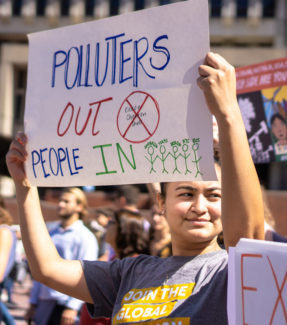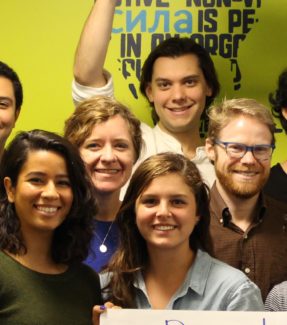- Colombian youth are exposed to tobacco promotion around their schools, with cigarette displays commonly featuring marketing attractive to youth, such as striking colors.
- Nearly 60% of documented cigarette displays are placed near candy and/or at eye level of youth. In 62% of cases, health warnings are obscured.
- 82% of documented vendors sell single cigarettes for an average of 15 cents each, making them more accessible to young people.
BOGOTA, COLOMBIA – Despite promising a “smoke-free future,” Big Tobacco continues to advertise its products to the next generation according to a report out today (May 10) authored by Corporate Accountability and Colombian NGO Educar Consumidores.
Big Tobacco, Tiny Targets: Colombia investigates the sale of tobacco products in close vicinity to schools and other places of interest to kids. While Colombia completely banned tobacco advertising, promotion, and sponsorship (TAPS) in 2009, the industry takes advantage of lax enforcement to heavily promote cigarettes and other tobacco products to kids. (View the full report in Spanish here and the executive summary in English here.)
Daniel Dorado, representative of Corporate Accountability for Latin America, said, “The tobacco industry is violating the rights of children and adolescents that are enshrined in the nation’s constitution. The authorities must protect these rights and hold corporations accountable for their transgressions.”
“The study shows that the degree of exposure of tobacco products faced by minors in the country is high,” emphasized Esperanza Cerón, physician and director of Educar Consumidores. “Where is the Superintendency of Industry and Commerce to take strong action on this obvious violation of Colombian law by the tobacco industry?”
Study Findings
Researchers identified a total of 196 points of sale of tobacco products that were close to schools and other areas of interest for children and adolescents. They found that:
- In 82% of cases, cigarettes are sold per unit rather than as a full pack, making them more accessible to young people.
- 66% of vendors are located on the street (kiosks and itinerant salespeople), meaning children are exposed to tobacco advertising without ever needing to enter a store.
- In 96% of the cases, the tobacco products were visible at the points of sale. In 55% of the cases, the products were exhibited at a child’s eye level. In 57% of the cases, their display was near sweets and treats.
- In 35% of the reported cases, the cigarettes were in a location that allowed consumers to access them without any intermediation by the seller.
Diana Vivas, lawyer and researcher at Educar Consumidores, commented that, “The display of tobacco products is carried out as an act of advertising, demonstrating a clear breach of the national and international regulations in force in Colombia, which prohibit the advertising and promotion of tobacco products and their derivatives.”
Vivas also notes that the law prohibits the sale of single cigarettes.
Researchers concluded that Colombian leaders must strengthen the implementation of public policies, use their authority to protect the space around educational institutions, and denounce the tobacco industry for violating the rights of children and adolescents.
“Tobacco companies like British American Tobacco and Philip Morris International will stop at nothing to market their products to kids in Colombia because they need to addict new customers,” says Patricia Sosa, Director of Programs for Latin America of the Campaign for Tobacco-Free Kids, which has collected data on tobacco marketing to children in more than 43 countries.
“The tactics used by Big Tobacco companies are not an accident – from surrounding schools with their cigarette brands and marketing to advertising cigarettes at a child’s eye level. These tactics have been intentionally designed to hook Colombian kids on deadly and addictive products.”
###



